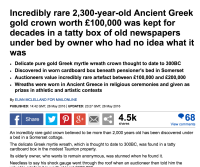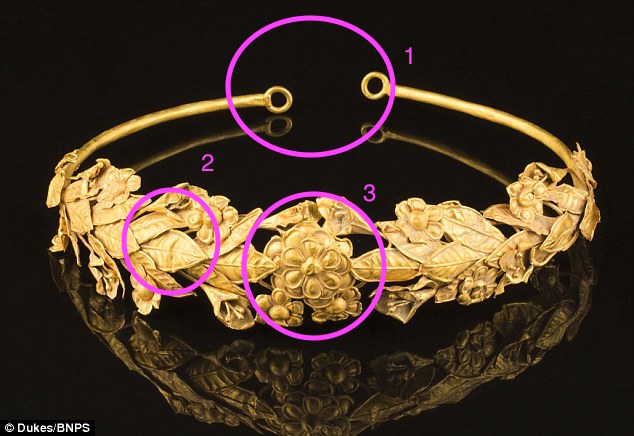From time to time I am asked why I link to the Daily Mail in my Explorator newsletter. As most folks are aware, the Daily Mail is a flashy, pop-culture-gossip-oriented British newspaper which generally is looked askance upon by folks who are fans of serious journalism. Indeed, when it comes to news about archaeology and/or the ancient Greek and Roman worlds, almost without exception something found in the Daily Mail will be a rewrite culled from other sources, but lavishly illustrated with tons of photos and usually a sidebar or two with useful background information. It is a guilty pleasure of sorts to regularly read it (for which I blame Dorothy King for removing the ‘stigma’ (if that’s right word)), but I do link to it precisely for the photos and sidebars. For the most part, the rewrites add nothing of value other than a bit of hype and a headline which may or may not fit comfortably into a tweet — which results in numerous rewrites of the headline over the course of the week. Whatever the case, the point of this long-winded introduction is to emphasize that when it comes to ‘breaking’ a news story about the ancient world, the Daily Mail generally isn’t the one to do it and their coverage of anything of the sort usually only pops in my mailbox after the story has appeared elsewhere.
 With that in mind, it was a very curious thing last Thursday, when — while the waves of coverage about that purported Aristotle tomb find were flooding my box — the Daily Mail seemed to be first off the mark with the story of a pensioner who had what was apparently a 2300 years bp Macedonian-style gold wreath in a box under his bed. I waited for the story to show up in a ‘more reputable’ source, but things didn’t unfold quite according to the established pattern. Indeed, it appears that all subsequent coverage was pretty much a rewrite of the Daily Mail (there’s one for you irony fans) … in order of appearance in my mailbox:
With that in mind, it was a very curious thing last Thursday, when — while the waves of coverage about that purported Aristotle tomb find were flooding my box — the Daily Mail seemed to be first off the mark with the story of a pensioner who had what was apparently a 2300 years bp Macedonian-style gold wreath in a box under his bed. I waited for the story to show up in a ‘more reputable’ source, but things didn’t unfold quite according to the established pattern. Indeed, it appears that all subsequent coverage was pretty much a rewrite of the Daily Mail (there’s one for you irony fans) … in order of appearance in my mailbox:
- A 2,300-year-old rare gold crown found in tatty cardboard box is worth a LOT of money (Mirror)
- Ancient Greek gold crown found in ratty box at English cottage (Toronto Sun … actually deriving from the Mirror piece; included only so our UK friends can see how ‘tatty’ becomes ‘ratty’ in Canada)
- Found in a tatty box under a bed. .. the Greek crown worth £100k (Dorset Echo)
- (Photos) 2,300 Year Old Stunning Ancient Greek Gold Crown Found by British Pensioner in a Box Under His Bed (Pappas Post)
The Daily Mail includes a pile of photos from the Duke’s of Dorchester auction house (more on that later) and most of the subsequent coverage picks one or more of those photos up as well. Here are the salient points from the Daily Mail and its derivatives:
- the pensioner from Somerset had the wreath in a box under his bed in Somerset (there’s a photo of the wreath in the box)
- he had inherited the piece from his grandfather, who had apparently travelled extensively in Northern Greece in the 1940s and 1950s (Paul Barford rightly draws our attention to the ubiquity of the ‘dead grandfather’ in questionably-sourced antiquities claims)
- Duke’s of Dorchester were called in to evaluate this (and other) items which were inherited
- According to the Daily Mail, the pensioner was told the item dated to about 300 BCE and was valued at £100 000.
- Here’s the important quote:
‘It is notoriously difficult to date gold wreaths of this type. Stylistically it belongs to a rarefied group of wreaths dateable to the Hellenistic period and the form may indicate that it was made in Northern Greece.
‘It is eight inches across and weighs about 100 grams. It’s pure gold and handmade, it would have been hammered out by a goldsmith.
- the wreath is said to be similar to one auctioned in 2012 for almost £200 000 and will be coming to auction June 9.
For my part, outside of the vagueness attached to the collecting history, I was skeptical in general of the authenticity of the piece (and was muttering about it on twitter with @CarolineLawrenc and @kyrikmk. Before I could look deeper into that, however, I came across the page at Duke’s for the auction. It was rather interesting how the story at the auction house was rather significantly different that what was in the Daily Mail and its derivatives:
- the piece is officially described as A ‘Hellenistic’ Gold Wreath (with the scare quotes; in the body of the text description, Hellenistic has regular quotation marks)
- the estimated price has dropped markedly: £10000-20000
- the collecting history has changed somewhat as well: “Acquired by the Grandfather of the vendor is the 1930’s and thence by descent Private Collection, Somerset”
Perhaps there is a policy at the Daily Mail to boost numbers whenever possible by a factor of ten (as seen in the price and the find date)? Whatever the case, the auction house does not seem to be on the same page as the Daily Mail at all.
As mentioned above, I had my own questions about the authenticity of the piece. I’ll preface this section by acknowledging that I am hardly an expert in Hellenistic gold wreaths, but I have seen my fair share of them. This one just didn’t ‘look right’ … here’s the photo from Duke’s which is in most of the press coverage. Obviously the pink circles were added by me:

- The first thing that made me do a Marge Simpson hmmmm are the two eyelets. They looked awfully modern and it was difficult to find an ancient example of a wreath with similar items. In fact, the only one which seemed ‘reliable’ was a piece at the Boston MFA and the ‘loops’ still look markedly different.
- All the leaves have a border/outline around the outside edge; I looked in vain for an ancient example of this and most other examples (including the Boston item) seem to be ‘scissor cut’ from a sheet of gold; these seem stamped or even cast. I would be happy if someone can point me to similar style leaves from the Hellenistic (or other) period.
- The flowers (which we are told are myrtles) have too many petals (six as opposed to five). Similarly, they seem to be stamped out as opposed to cut and soldered — most examples one can find on the web have individual leaves which seem to be attached to the center thing.
Taken together, there is much to be suspicious about this one. The disconnect between the accounts in the Daily Mail and the Duke’s of Dorchester official description are concerning at least from a collection history point of view. The huge difference in valuation also suggests the auction house might not be as enthusiastic about this as the Daily Mail would have us believe. Outside of that, the wreath itself has several features which just don’t ‘seem right’ from a Hellenistic gold wreath point of view. We’ll continue to watch how this one develops …

Bare in mind I have zero knowledge of Hellenistic wreathes. I do have a bit of knowledge of 19th c. jewelry and art, and this looks like an early 1800’s piece to me. I leave open the possibility that I’m way off, but it was the first thought when I saw the Daily Mail headline & picture. Grecian, not Greek, especially considering the collector’s country of origin. It’s still lovely.
I was thinking 19th c and scrolling through websites — that perhaps it was looted in the 40s but from Holocaust victims, not an illegally excavated Greek tomb.

And then I found this which has flowers similar to the central “not-daisy” in the rediscovered wreath…and has a clear provenance.
That has good comparanda potential, although those items are much larger than the wreath … similar idea. In that same exhibition are gold masks with the same motif on the eyes. There is a consistent ‘eight petals’ though … perhaps inspiration?
Could be a costume piece from the 1800’s. Sometimes masquerade ball costumes included some pretty pricey elements.